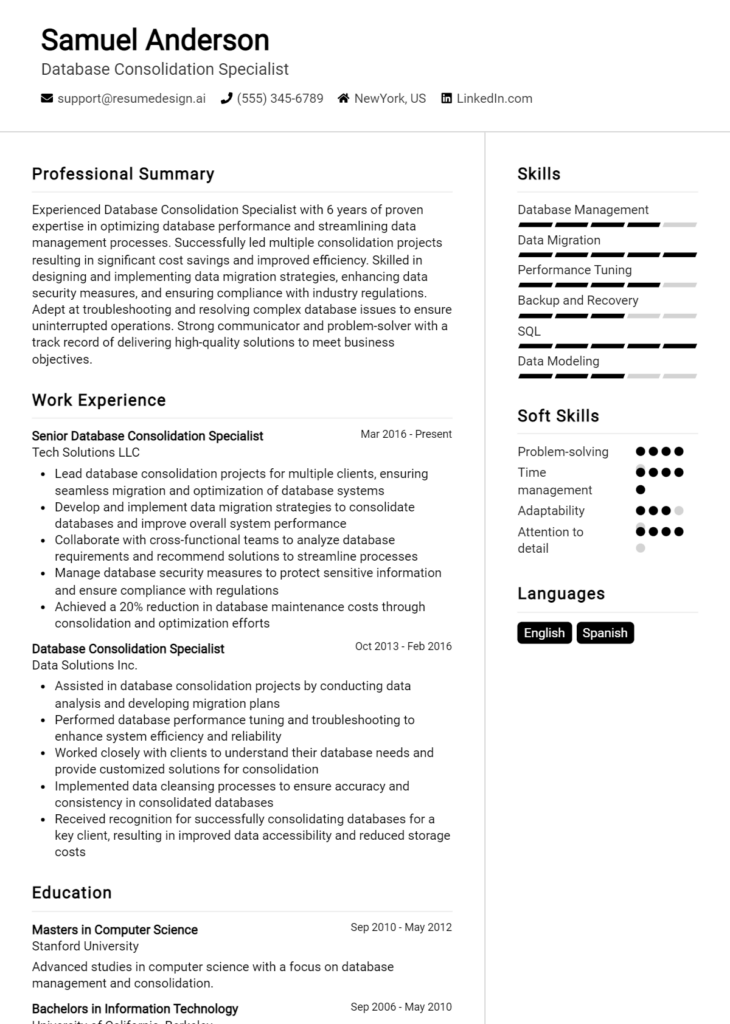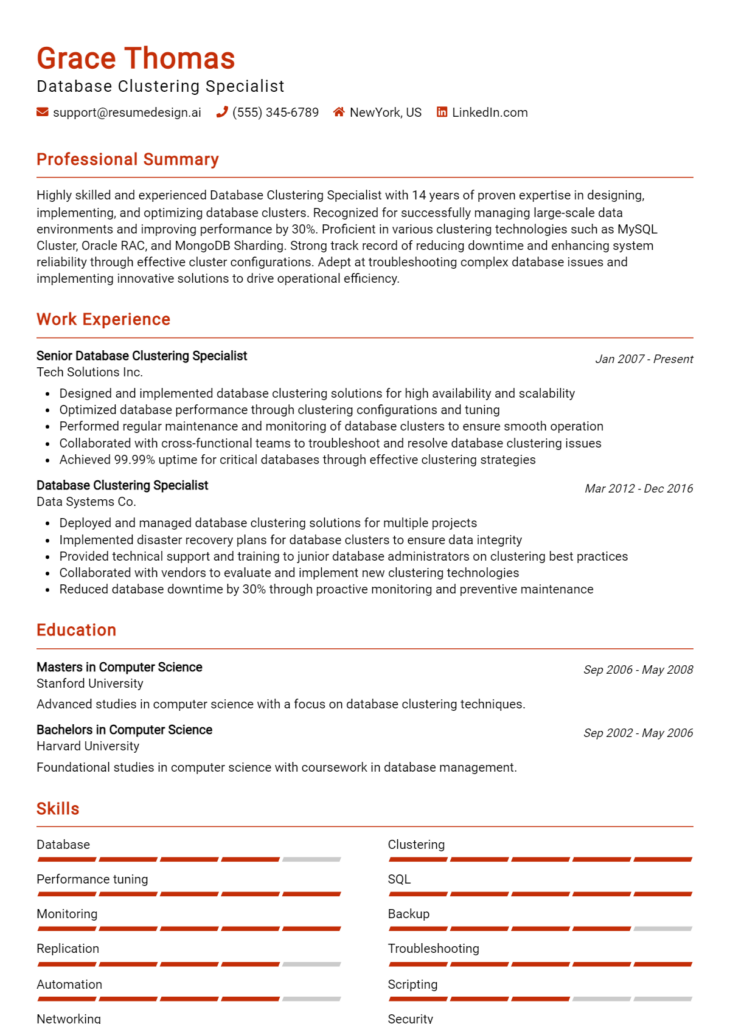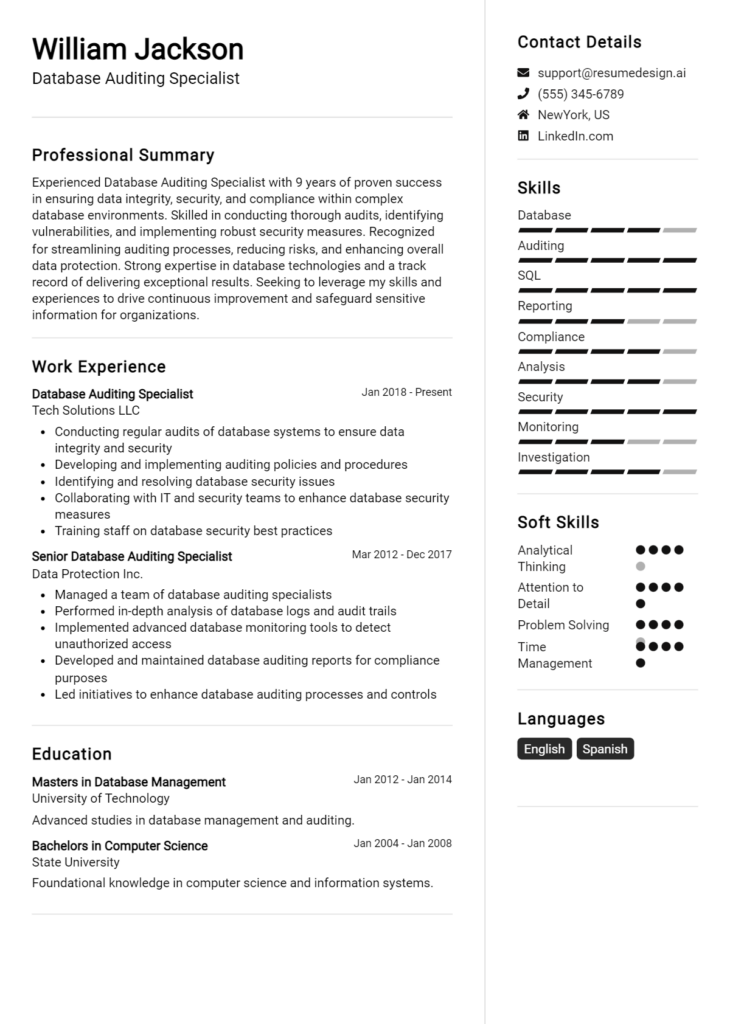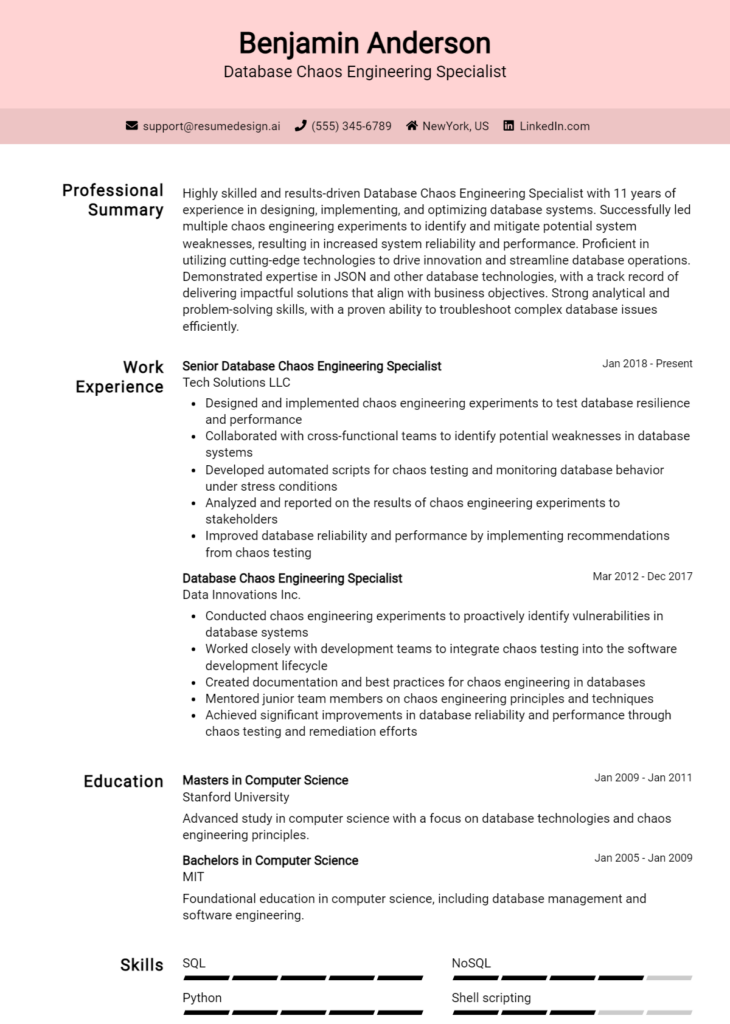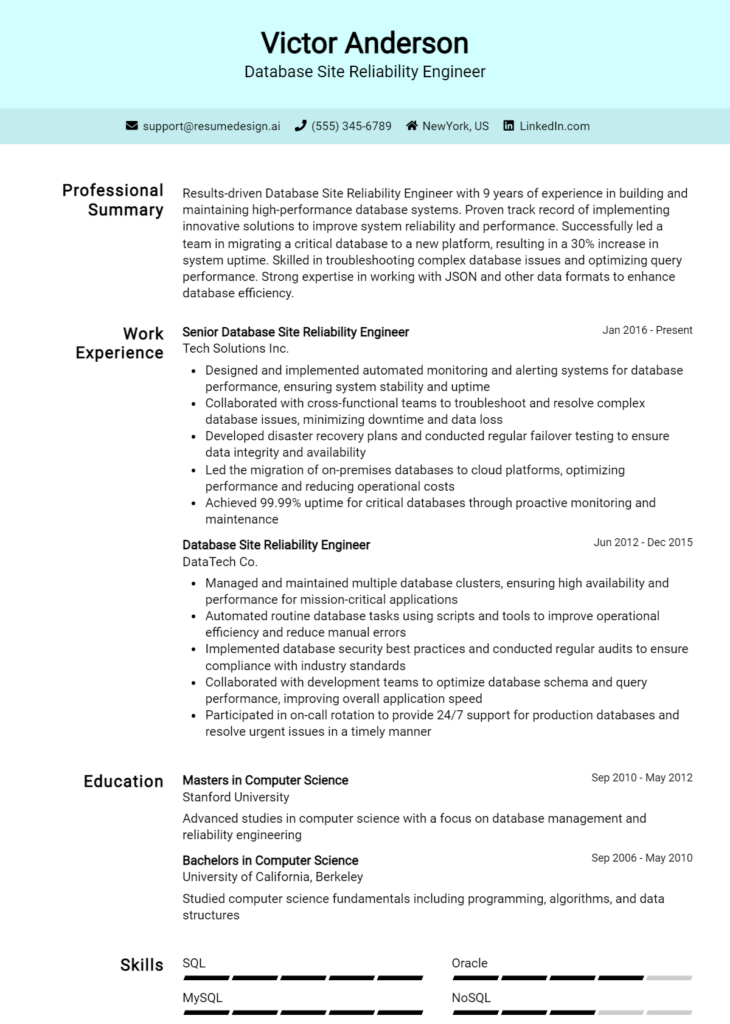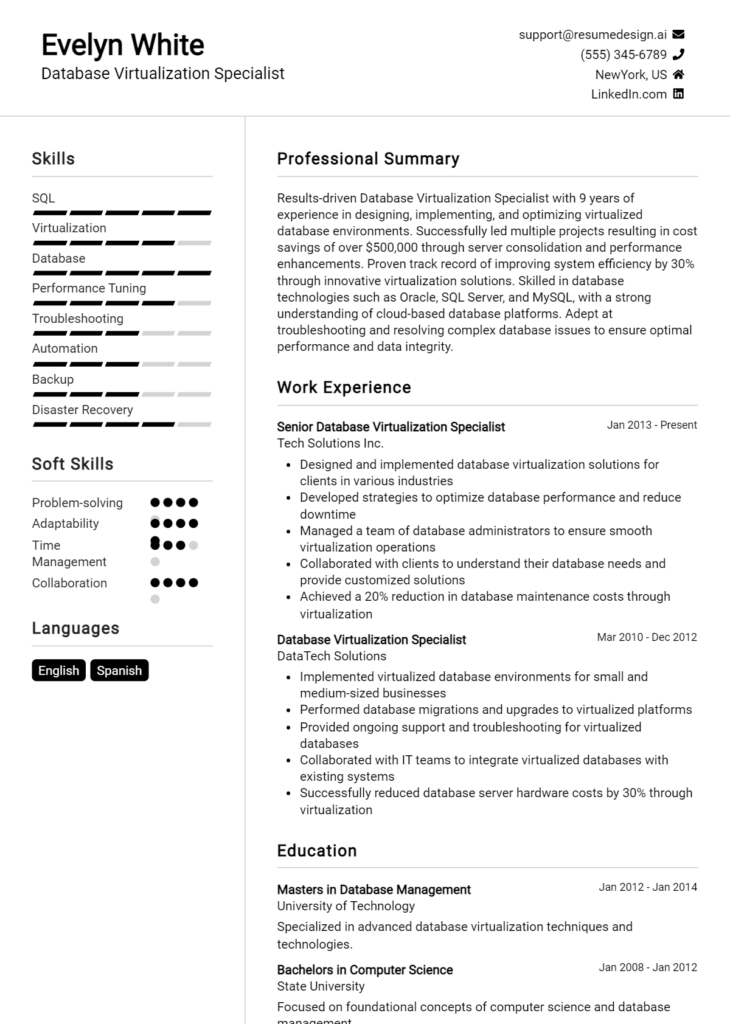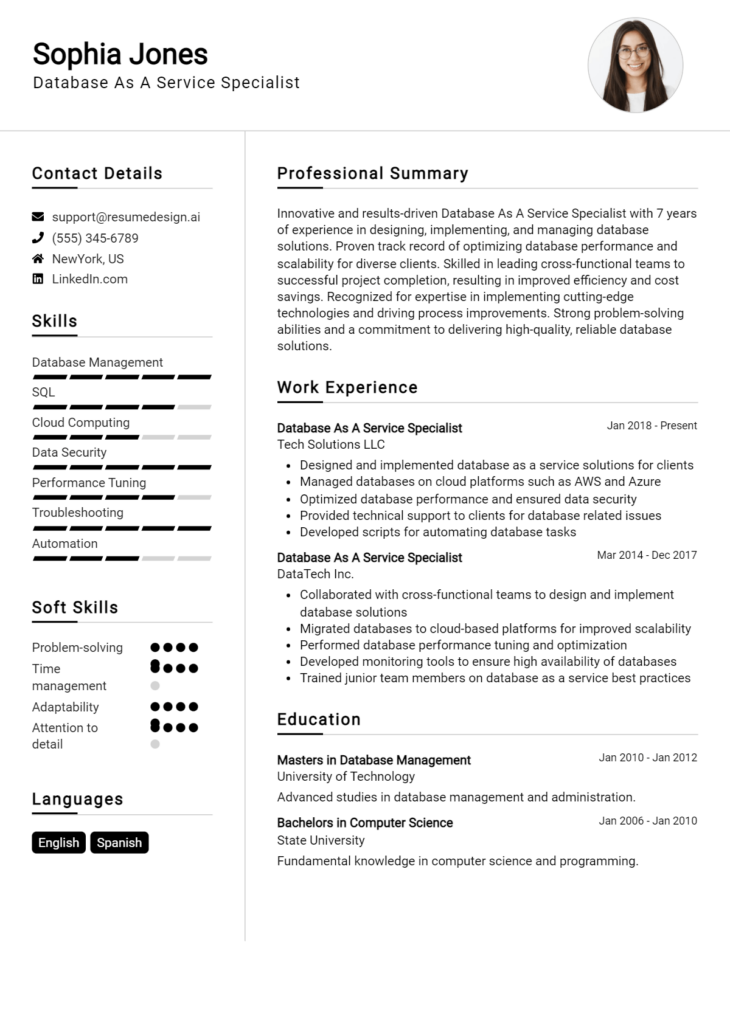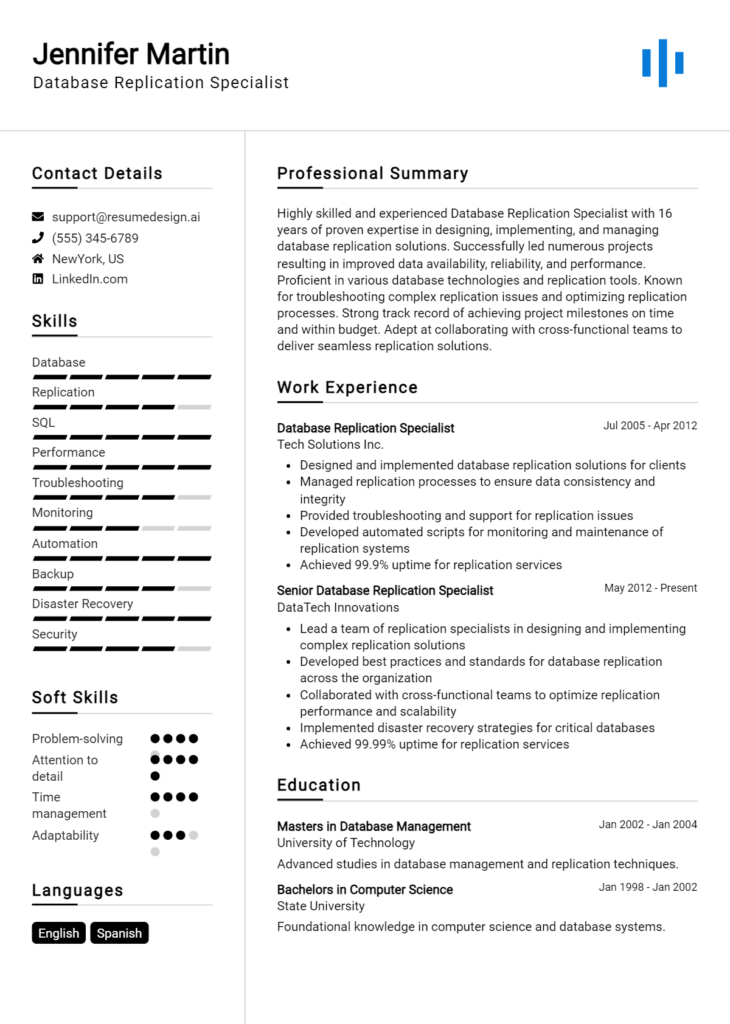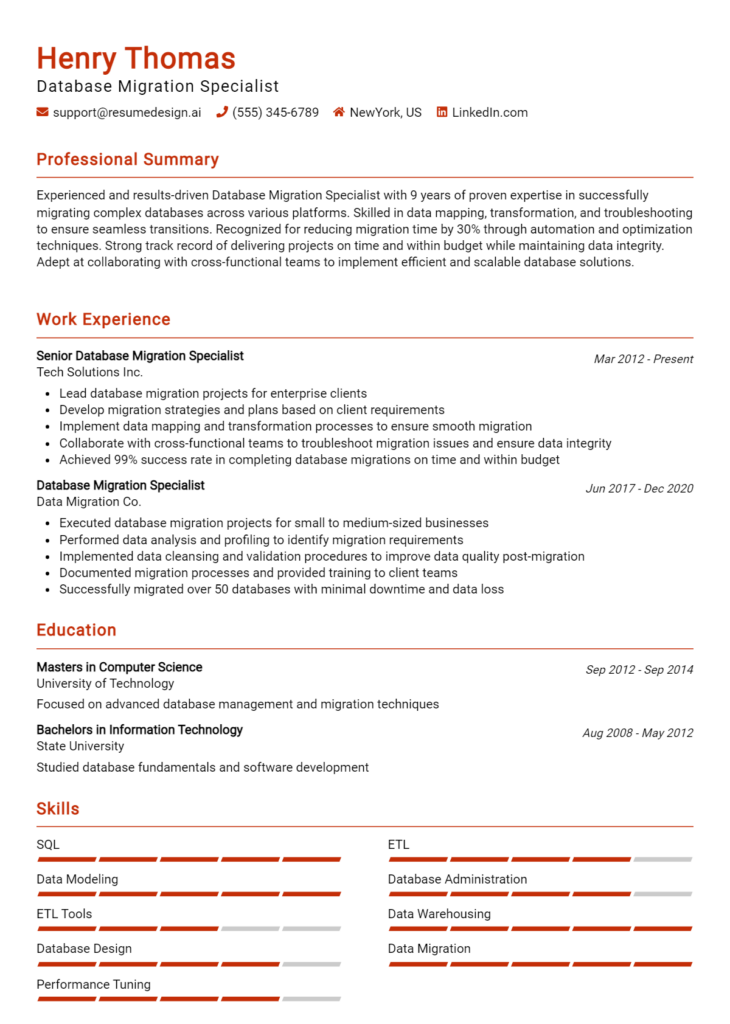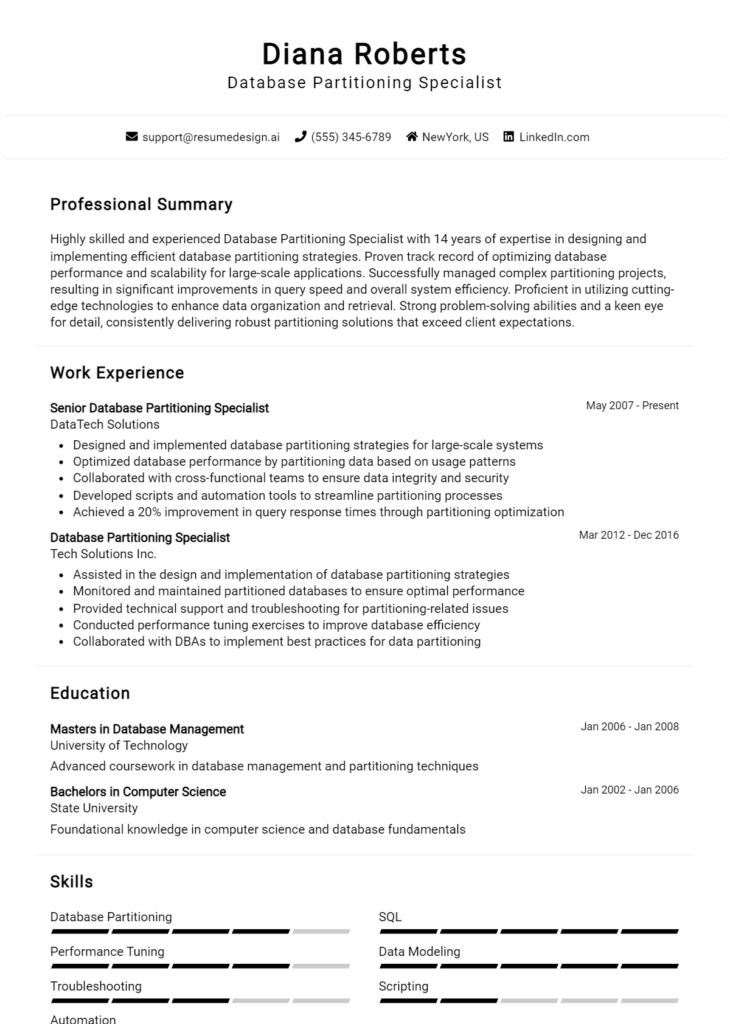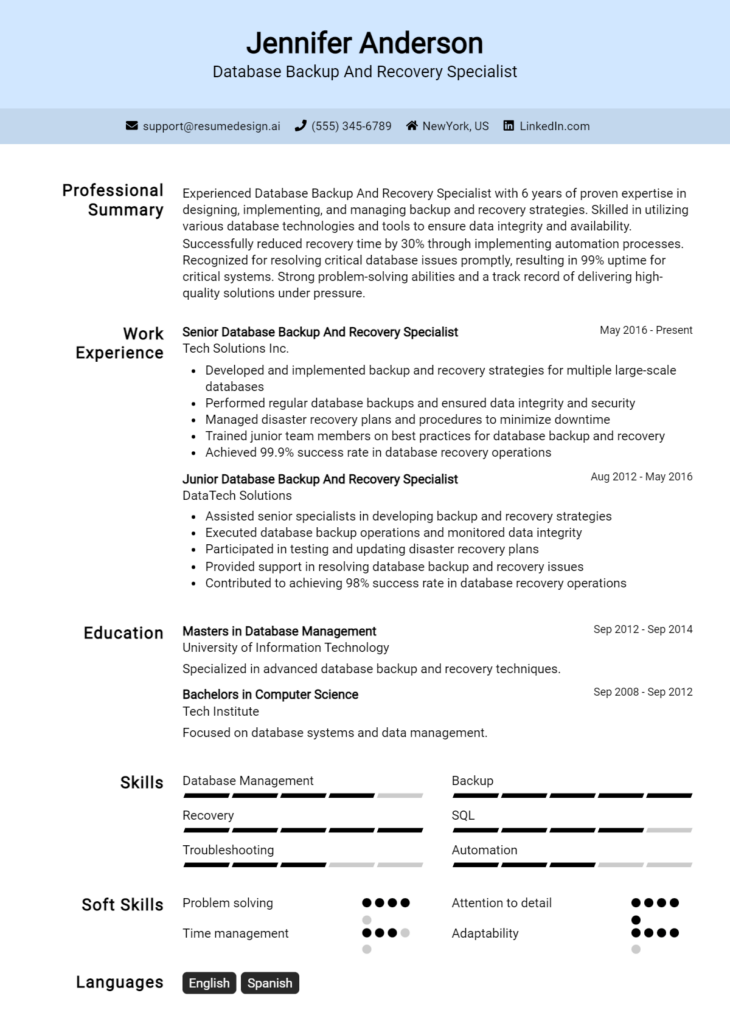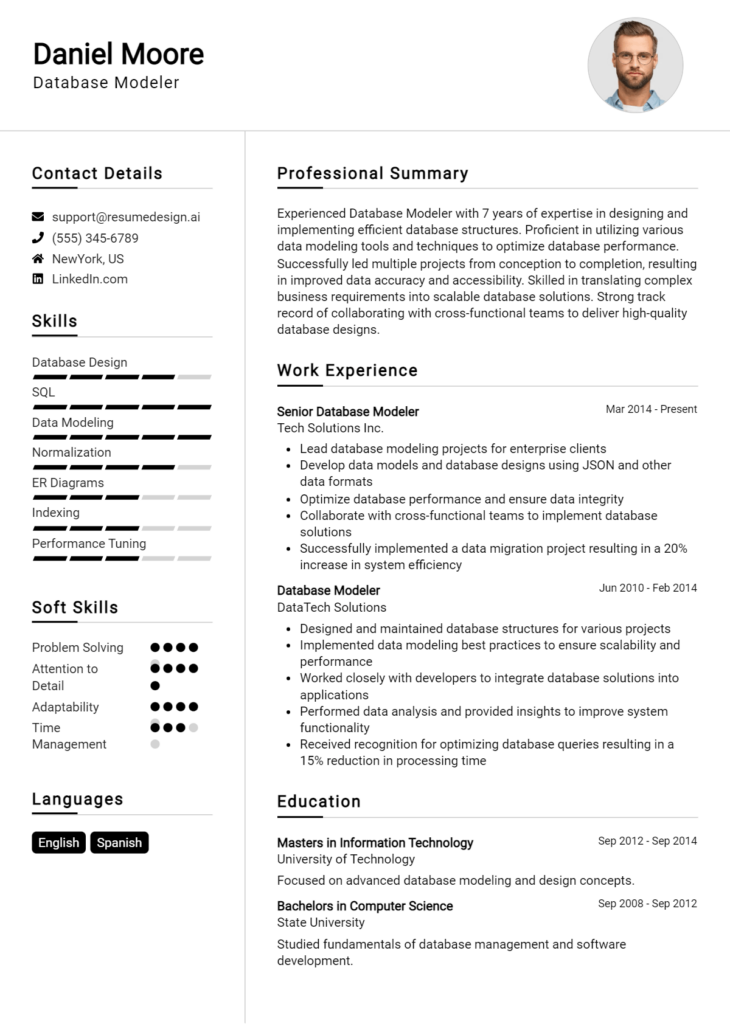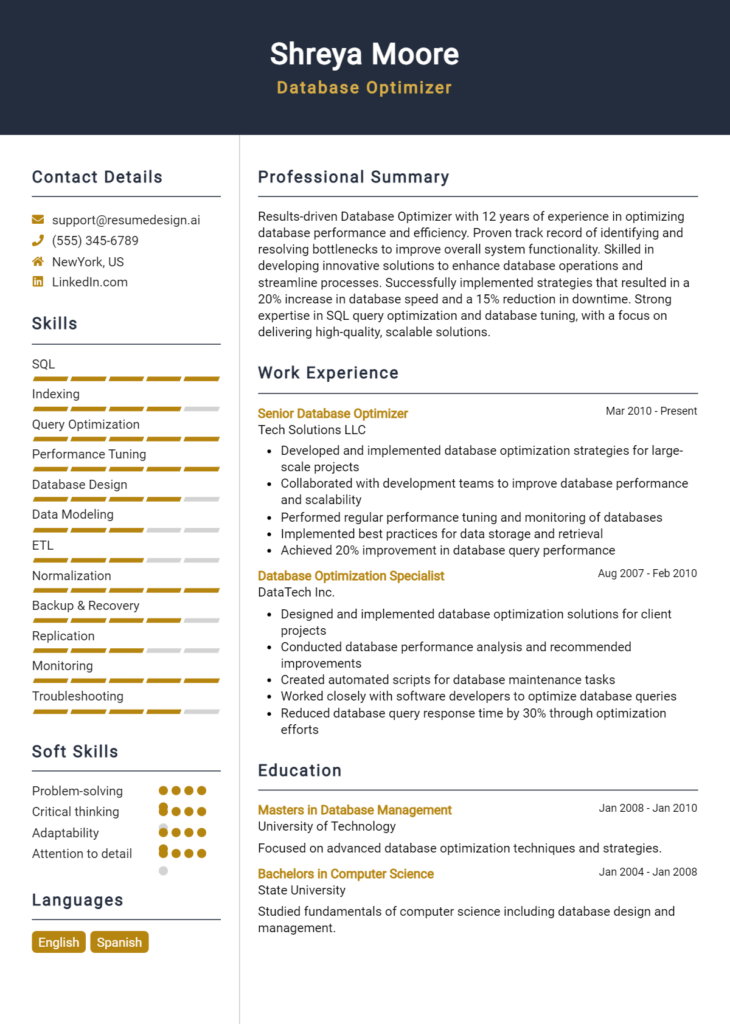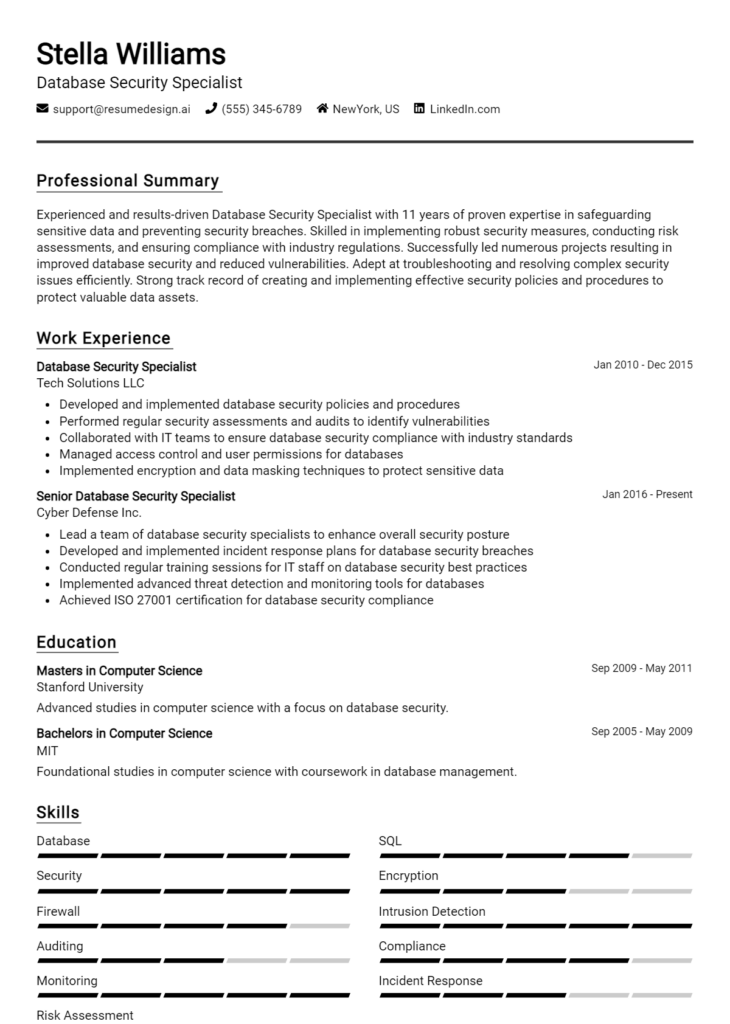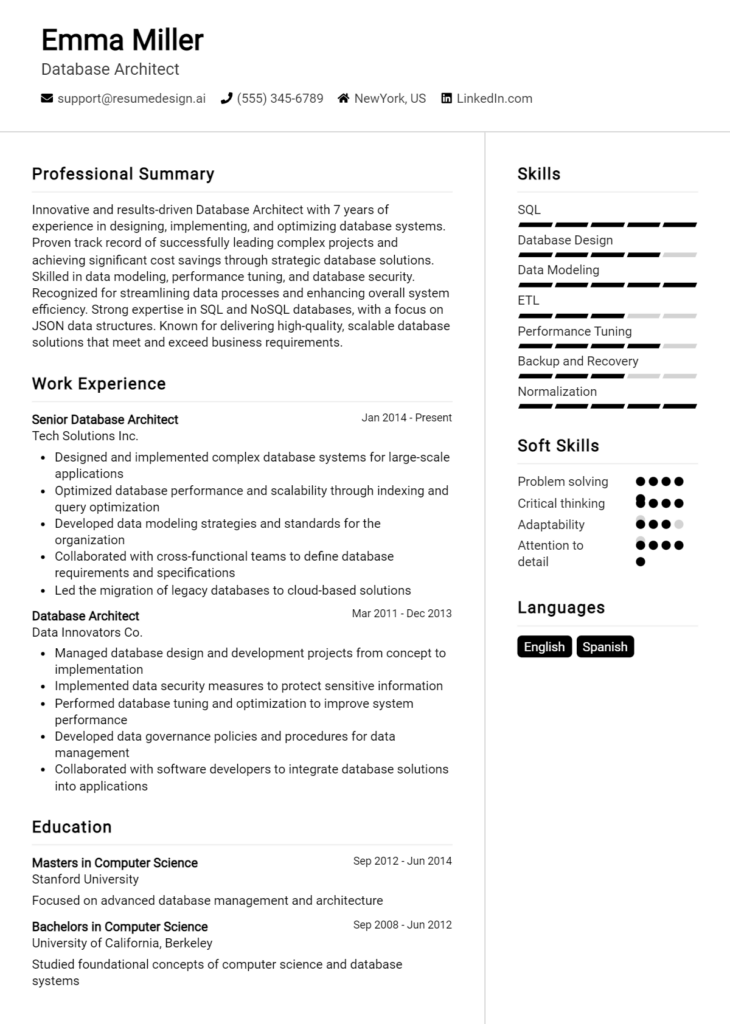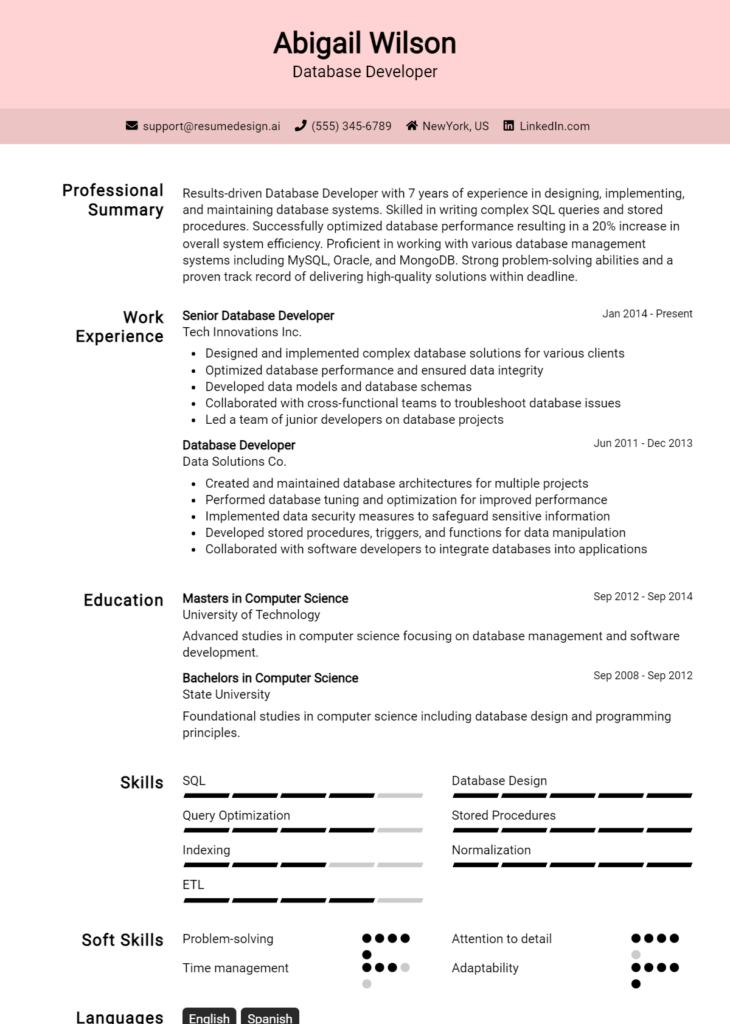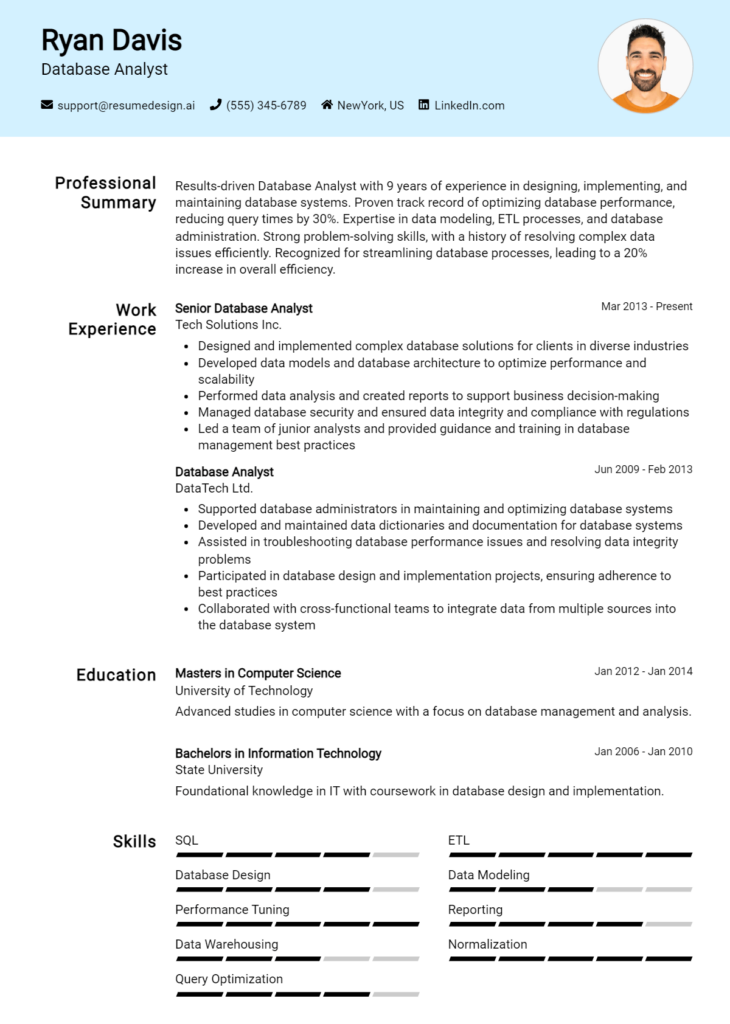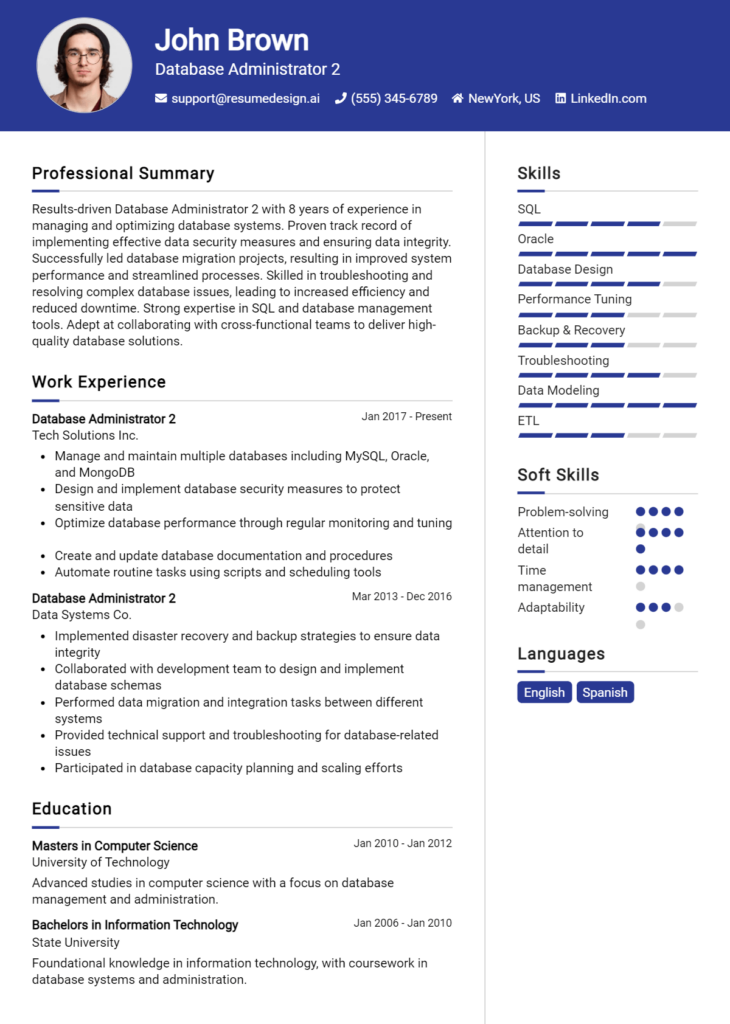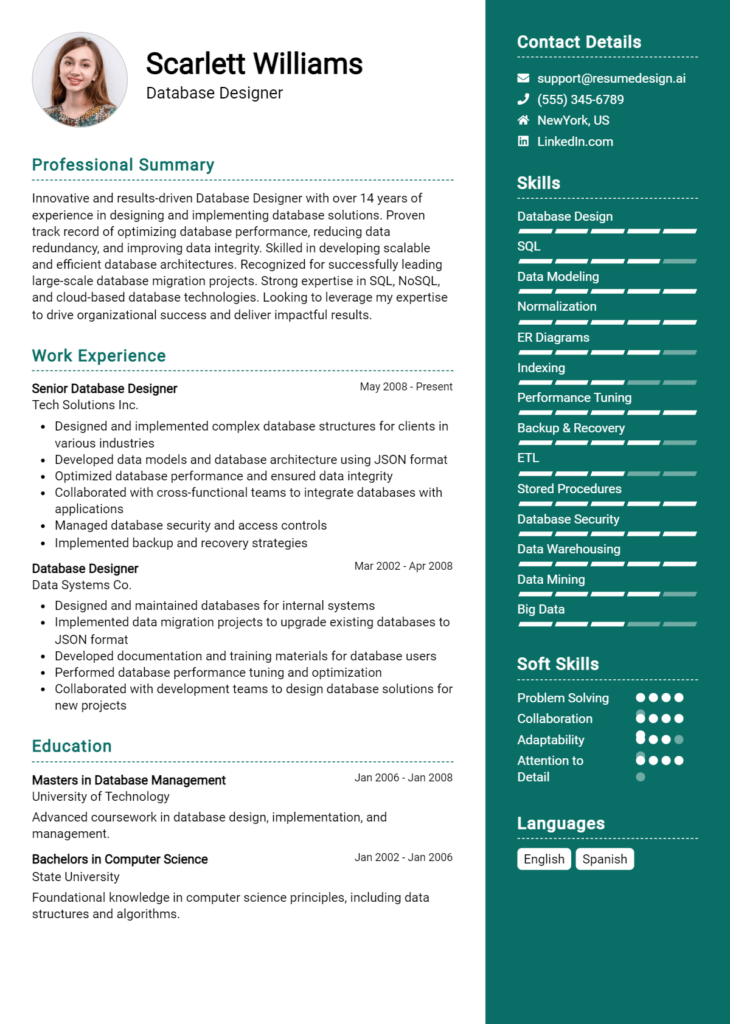Database Sharding Specialist Core Responsibilities
A Database Sharding Specialist is responsible for designing, implementing, and managing sharding strategies that optimize database performance and scalability. This role requires a blend of technical expertise in database management systems, operational knowledge of data architecture, and strong problem-solving skills to address challenges across departments. Collaborating with development, operations, and data analytics teams, the specialist ensures seamless data distribution and retrieval, contributing significantly to the organization’s efficiency and growth. A well-crafted resume that highlights these competencies can effectively demonstrate a candidate’s value to potential employers.
Common Responsibilities Listed on Database Sharding Specialist Resume
- Design and implement sharding strategies for large-scale databases.
- Monitor database performance and optimize queries for efficiency.
- Collaborate with cross-functional teams to ensure data integrity.
- Develop documentation for sharding processes and best practices.
- Troubleshoot and resolve database-related issues quickly.
- Conduct capacity planning and resource allocation for sharded environments.
- Evaluate and recommend tools for effective sharding management.
- Stay updated on emerging trends in database technologies.
- Provide training and support to team members on sharding techniques.
- Implement security measures to protect sharded data.
- Analyze data distribution patterns to optimize performance.
- Work with data engineers to refine data ingestion processes.
High-Level Resume Tips for Database Sharding Specialist Professionals
In today's competitive job market, a well-crafted resume is essential for Database Sharding Specialist professionals who want to stand out to potential employers. Your resume is often the first impression you make, and it needs to effectively showcase your skills, experience, and achievements in the field of database management and sharding solutions. A strong resume not only highlights your technical capabilities but also demonstrates your value to an organization by showcasing your past successes. This guide will provide practical and actionable resume tips specifically tailored for Database Sharding Specialist professionals, enabling you to present yourself as a compelling candidate.
Top Resume Tips for Database Sharding Specialist Professionals
- Tailor your resume for each job application by incorporating keywords from the job description.
- Highlight relevant experience in database management and sharding, emphasizing projects you've worked on.
- Quantify your achievements with metrics, such as performance improvements or cost savings resulting from sharding implementations.
- Showcase industry-specific skills, such as knowledge of various database systems (e.g., MySQL, MongoDB) and sharding techniques.
- Include certifications or training related to database technologies and sharding frameworks.
- Demonstrate your problem-solving skills by outlining challenges you faced in past projects and how you overcame them.
- Use clear and concise language, avoiding jargon unless it is widely recognized in the industry.
- Keep your resume well-structured with clear headings and bullet points for easy readability.
- Incorporate a professional summary at the top that encapsulates your expertise and career goals.
- Proofread carefully to eliminate errors, as attention to detail is crucial in the tech industry.
By implementing these tips, you can significantly increase your chances of landing a job as a Database Sharding Specialist. A targeted and polished resume not only highlights your qualifications but also demonstrates your professionalism and readiness to contribute to potential employers' success in managing and optimizing their database environments.
Why Resume Headlines & Titles are Important for Database Sharding Specialist
In the competitive field of database management, a Database Sharding Specialist plays a crucial role in optimizing and scaling data storage solutions. When applying for such a position, having a compelling resume headline or title is imperative. A strong headline not only grabs the attention of hiring managers but also provides a succinct summary of a candidate's key qualifications in one impactful phrase. It should be concise, relevant, and directly related to the job being applied for, allowing the candidate to stand out in a crowded applicant pool.
Best Practices for Crafting Resume Headlines for Database Sharding Specialist
- Keep it concise: Limit your headline to one impactful sentence.
- Be specific: Clearly state your expertise in database sharding.
- Highlight key skills: Include your most relevant skills and technologies.
- Use action-oriented language: Start with strong verbs that convey your expertise.
- Tailor to the job: Align your headline with the specific job description.
- Showcase achievements: Mention any significant accomplishments that demonstrate your impact.
- Avoid jargon: Use clear language that can be understood by all hiring managers.
- Make it memorable: Use unique phrasing to leave a lasting impression.
Example Resume Headlines for Database Sharding Specialist
Strong Resume Headlines
"Expert Database Sharding Specialist with 5+ Years of Experience in High-Availability Systems"
“Data Architect Focused on Scalable Sharding Solutions for Enterprise-Level Applications”
“Innovative Database Sharding Specialist Delivering 99.9% Uptime through Advanced Sharding Techniques”
Weak Resume Headlines
“Database Specialist Looking for Opportunities”
“Experienced IT Professional”
The strong headlines are effective because they are direct, specific, and emphasize the candidate's unique qualifications and achievements, making them easily memorable to hiring managers. In contrast, the weak headlines fail to impress due to their vagueness and lack of relevance, failing to communicate any specific skills, accomplishments, or the candidate's value proposition to potential employers.
Writing an Exceptional Database Sharding Specialist Resume Summary
A resume summary is a crucial component for a Database Sharding Specialist, as it serves as the first impression a hiring manager receives from a candidate's application. A well-crafted summary quickly captures attention by highlighting essential skills, relevant experience, and notable accomplishments that align with the job role. It should be concise yet impactful, offering a snapshot of the candidate's qualifications tailored specifically to the position being applied for. This strategic approach not only piques the interest of hiring managers but also sets the tone for the rest of the resume, emphasizing the candidate's fit for the role.
Best Practices for Writing a Database Sharding Specialist Resume Summary
- Quantify your achievements to demonstrate impact (e.g., reduced database latency by 30%).
- Focus on specific skills relevant to database sharding, such as partitioning strategies and performance tuning.
- Tailor your summary to match the job description, using keywords that align with the role.
- Keep it concise, ideally 3-5 sentences that encapsulate your experience and expertise.
- Highlight relevant certifications or education in database management and sharding techniques.
- Use action verbs to convey a sense of proactivity and ownership in your previous roles.
- Include any experience with specific tools or technologies related to sharding, such as MongoDB, MySQL, or Apache Cassandra.
- Showcase your problem-solving abilities by mentioning specific challenges you've overcome in previous positions.
Example Database Sharding Specialist Resume Summaries
Strong Resume Summaries
Results-driven Database Sharding Specialist with over 7 years of experience in optimizing database performance for high-traffic applications. Successfully implemented sharding strategies that improved data access speeds by 40%, while reducing operational costs by 20% through efficient resource allocation.
Detail-oriented Database Sharding Specialist skilled in designing and managing distributed databases. Achieved a 50% reduction in query response times by developing a robust sharding architecture for an e-commerce platform serving over 1 million users.
Innovative Database Sharding Specialist with expertise in MongoDB and MySQL, adept at implementing scalable solutions to handle growing data volumes. Instrumental in a project that transitioned from monolithic to sharded architecture, resulting in a 35% increase in application performance.
Weak Resume Summaries
Experienced database professional with skills in sharding and database management. Looking for opportunities to improve database systems.
Database Sharding Specialist with knowledge of various technologies. I can help with database performance and sharding.
The strong resume summaries are considered effective because they provide specific, quantifiable results that demonstrate the candidate's impact in their previous roles, while also highlighting relevant skills and technologies. They are tailored to showcase the candidate's direct relevance to the Database Sharding Specialist position. In contrast, the weak summaries lack detail and specificity, making them vague and generic. They fail to convey any measurable achievements or clear relevance to the role, which diminishes their effectiveness in capturing a hiring manager's attention.
Work Experience Section for Database Sharding Specialist Resume
The work experience section of a Database Sharding Specialist resume is crucial, as it serves as a window into the candidate's practical knowledge and expertise in the field. This section showcases the candidate's technical skills in database management and sharding techniques, as well as their ability to lead teams effectively and deliver high-quality products. By quantifying achievements and aligning their experience with industry standards, candidates can demonstrate their impact and value to potential employers, making it easier for hiring managers to assess their fit for the role.
Best Practices for Database Sharding Specialist Work Experience
- Highlight specific sharding techniques and technologies used in past projects.
- Quantify achievements with metrics, such as performance improvements or cost reductions.
- Demonstrate leadership skills by detailing team management and project oversight.
- Align experiences with industry standards and best practices in database management.
- Include collaboration examples that showcase teamwork and cross-departmental initiatives.
- Focus on results-driven narratives that illustrate the impact of your work.
- Use action verbs to convey a sense of initiative and accomplishment.
- Tailor experiences to the job description to enhance relevance.
Example Work Experiences for Database Sharding Specialist
Strong Experiences
- Led a team of 5 in implementing a sharding solution that improved query response time by 40%, enhancing user experience and increasing customer satisfaction.
- Designed and executed a database migration strategy that reduced downtime by 30% and saved the company $100,000 annually in operational costs.
- Collaborated with cross-functional teams to develop a sharding framework that supported a 200% increase in data volume while maintaining system performance.
- Conducted a comprehensive analysis of existing database architecture, leading to the identification and resolution of bottlenecks that boosted system efficiency by 50%.
Weak Experiences
- Worked on database projects that involved sharding.
- Assisted in optimizing databases without specific outcomes or metrics.
- Participated in team meetings regarding database management.
- Helped with various tasks related to database systems.
The examples listed as strong experiences are considered impactful because they provide specific details about the candidate's contributions, including quantifiable outcomes and leadership roles that demonstrate real value added to the organizations they worked for. In contrast, the weak experiences lack specificity and measurable results, failing to convey the candidate's true capabilities and contributions within their roles. This distinction highlights the importance of crafting clear, results-oriented statements that resonate with hiring managers.
Education and Certifications Section for Database Sharding Specialist Resume
The education and certifications section of a Database Sharding Specialist resume plays a crucial role in establishing the candidate's qualifications and expertise in database management and optimization techniques. This section not only outlines the candidate's academic background but also showcases industry-relevant certifications and ongoing learning endeavors. By providing detailed information on relevant coursework, specialized training, and recognized certifications, candidates can significantly enhance their credibility and demonstrate their alignment with the job role, making them more attractive to potential employers in a competitive landscape.
Best Practices for Database Sharding Specialist Education and Certifications
- Focus on relevant degrees in Computer Science, Information Technology, or related fields.
- List industry-recognized certifications such as AWS Certified Database Specialty or Microsoft Certified: Azure Database Administrator Associate.
- Include coursework that specifically addresses database design, sharding, and distributed systems.
- Highlight any specialized training or workshops attended that relate to database management and performance optimization.
- Ensure certifications are current and renew them as needed to reflect ongoing professional development.
- Consider including any relevant internships or projects that demonstrate practical application of sharding techniques.
- Use clear and concise language to describe qualifications, focusing on achievements and skills gained.
- Tailor this section to align with the specific requirements of the job description.
Example Education and Certifications for Database Sharding Specialist
Strong Examples
- Bachelor of Science in Computer Science, University of Technology, 2020
- AWS Certified Database Specialty, Amazon Web Services, 2022
- Coursework: Advanced Database Systems, Distributed Database Management, and Performance Tuning
- Certified Database Administrator (CDBA), International Database Certification Board, 2021
Weak Examples
- Bachelor of Arts in English Literature, University of Arts, 2018
- Certification in Basic Computer Skills, Local Community College, 2019
- Coursework: Introduction to Psychology and History of Art
- Outdated certification in Windows Server Administration from 2015
The examples are considered strong when they directly relate to the skills and knowledge required for a Database Sharding Specialist role, showcasing relevant degrees, current certifications, and applicable coursework. These credentials demonstrate a solid foundation in database technologies and a commitment to professional development. In contrast, the weak examples illustrate a lack of relevance to the field, featuring degrees and certifications that do not contribute to the candidate's qualifications for a specialized database role, which ultimately detracts from their candidacy.
Top Skills & Keywords for Database Sharding Specialist Resume
In the competitive landscape of database management, the role of a Database Sharding Specialist is critical for optimizing performance and ensuring scalability. As businesses grow, the need for efficient data distribution becomes paramount. A well-crafted resume for this position should showcase a blend of both soft and hard skills that highlight the candidate's expertise. By effectively demonstrating these skills, applicants can set themselves apart from the competition and illustrate their ability to manage complex systems efficiently. For a comprehensive understanding of how to present these skills and relevant work experience, candidates should focus on the specific abilities that cater to the nuances of database sharding.
Top Hard & Soft Skills for Database Sharding Specialist
Soft Skills
- Problem-solving
- Communication
- Team collaboration
- Adaptability
- Analytical thinking
- Attention to detail
- Time management
- Critical thinking
- Project management
- Conflict resolution
Hard Skills
- Database architecture design
- SQL proficiency
- NoSQL databases (e.g., MongoDB, Cassandra)
- Sharding techniques and strategies
- Performance tuning and optimization
- Data modeling
- Distributed systems knowledge
- Backup and recovery strategies
- Cloud database services (e.g., AWS, Azure)
- Scripting languages (e.g., Python, Bash)
- Monitoring and analytics tools
- Security best practices in data management
- Familiarity with microservices architecture
- Understanding of CAP theorem and its implications
Stand Out with a Winning Database Sharding Specialist Cover Letter
Dear [Hiring Manager's Name],
I am writing to express my interest in the Database Sharding Specialist position at [Company Name], as advertised on [where you found the job listing]. With a robust background in database architecture and a deep understanding of distributed systems, I am confident in my ability to optimize data management and enhance system performance through effective sharding strategies. My experience with both SQL and NoSQL databases, combined with my passion for innovative data solutions, makes me an ideal candidate for this role.
In my previous position at [Previous Company Name], I successfully led a project to implement sharding in a high-traffic web application that resulted in a 50% increase in query performance and a significant reduction in server load. By analyzing data access patterns and user behavior, I developed a customized sharding strategy that not only improved response times but also provided scalability for future growth. My hands-on experience with cloud-based database solutions, such as AWS DynamoDB and Google Cloud Spanner, allows me to leverage cutting-edge technologies to address complex data challenges.
I am particularly drawn to [Company Name] because of your commitment to innovation and excellence in technology. I admire your work in [specific project or value of the company], and I am eager to contribute my skills to help further enhance your database infrastructure. I thrive in collaborative environments and have a proven track record of engaging cross-functional teams to implement solutions that align with business objectives. My dedication to continuous learning and improvement will ensure that I stay ahead of industry trends and best practices in database management.
I look forward to the opportunity to discuss how my expertise in database sharding can contribute to the continued success of [Company Name]. Thank you for considering my application. I am excited about the possibility of joining your team and helping to drive data excellence within your organization.
Sincerely,
[Your Name]
[Your LinkedIn Profile]
[Your Contact Information]
Common Mistakes to Avoid in a Database Sharding Specialist Resume
When crafting a resume for the position of a Database Sharding Specialist, it's crucial to highlight relevant skills and experiences that align with the unique demands of this role. However, many candidates fall into common pitfalls that can undermine their chances of standing out to potential employers. By being aware of these mistakes, you can enhance the effectiveness of your resume and demonstrate your expertise in database management and sharding techniques.
Neglecting Relevant Skills: Failing to specifically list skills related to sharding, such as knowledge of partitioning strategies or experience with NoSQL databases, can make your resume less appealing to hiring managers.
Using Generic Job Descriptions: Many candidates list their responsibilities in previous roles without tailoring them to sharding. Be specific about how you implemented sharding techniques or improved database performance.
Omitting Metrics and Achievements: Resumes that lack quantifiable achievements (e.g., "reduced query time by 30% through effective sharding") miss the opportunity to showcase your impact and contributions.
Ignoring Industry Terminology: Not using industry-specific language or jargon can make your resume sound generic. Familiarity with terms like "horizontal scaling," "database partitioning," and "load balancing" is essential.
Overlooking Relevant Tools and Technologies: Failing to mention specific tools or technologies you’ve used (e.g., MongoDB, Cassandra, or Vitess) can lead to your resume being overlooked by applicant tracking systems.
Focusing Too Much on Theoretical Knowledge: While understanding database theory is important, employers value practical experience. Highlight hands-on projects or implementations that demonstrate your sharding expertise.
Not Including Certifications or Continuing Education: If you have relevant certifications (e.g., from Oracle or MongoDB), omitting them can be a missed opportunity to validate your expertise in database sharding.
Formatting Issues: A cluttered or poorly organized resume can detract from your qualifications. Ensure your resume is clean, concise, and visually appealing to make a strong first impression.
Conclusion
In conclusion, the role of a Database Sharding Specialist is critical in the modern data landscape, where scalability and performance are paramount. Throughout the article, we explored the essential skills and qualifications required for this position, including a deep understanding of database architecture, sharding techniques, and performance tuning. We also discussed the importance of hands-on experience with various database management systems and the ability to work collaboratively with development teams to ensure optimal data distribution.
As you reflect on your career as a Database Sharding Specialist, take a moment to review your resume to ensure it highlights your expertise and experience in this niche. A well-crafted resume can make a significant difference in the competitive job market.
To assist you in this process, we encourage you to check out the following resources:
- Explore a variety of resume templates that can give your application a professional look.
- Use a resume builder to create a customized resume that showcases your unique skills and experiences.
- Browse through resume examples to gain inspiration and identify the best practices in your field.
- Don’t forget to enhance your application with a compelling cover letter using our cover letter templates.
Take action today to ensure your resume aligns with your career goals and stands out to potential employers!


